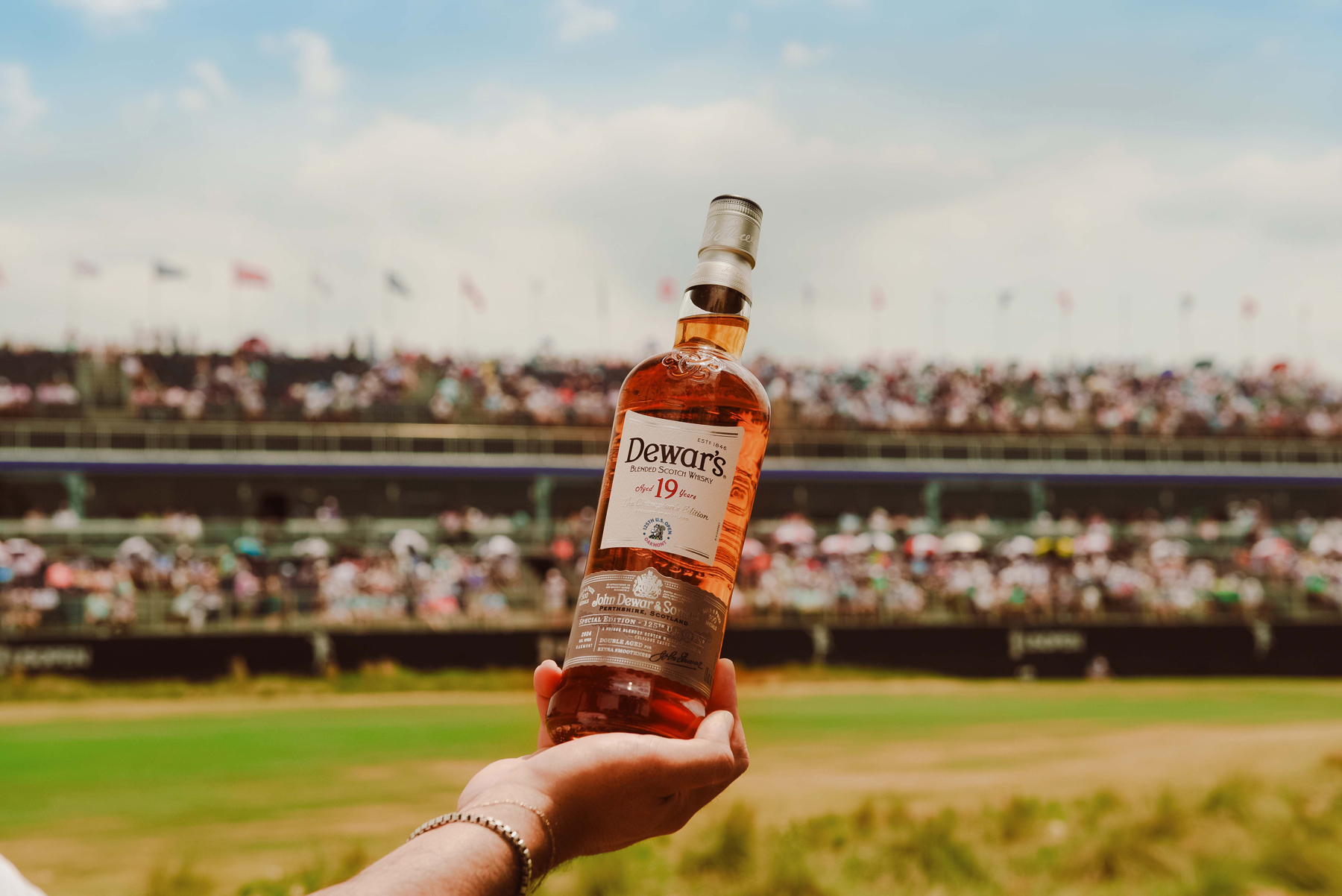
Kingdom’s series of notional golf courses—comprising real holes from different courses—here pays its dues to the Ryder Cup with a layout made up of the finest holes that have seen Ryder Cup action. As ever with our compilations, it wasn’t easy. A lot of great holes and classic courses missed the cut but this is the Ryder Cup, the most intense match play event there is, and there is no room for sentiment. Here are 18 fantastic Ryder Cup holes and it is a blessing this round of golf could never occur in reality because it might just be the toughest ever conceived.
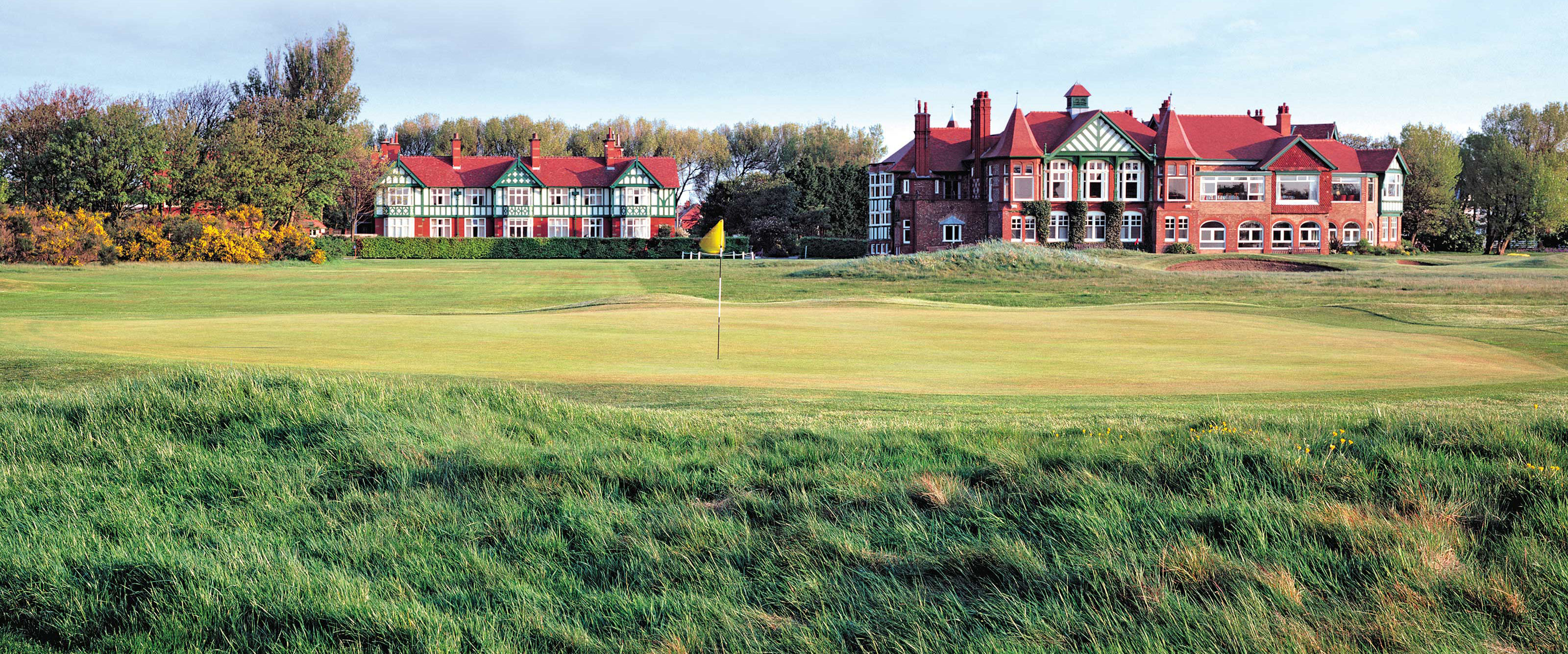
Royal Lytham & St Annes
Lancashire, England
Par 3, 198 yards, Handicap 11
Tony Jacklin described the first at Lytham as a “terrible strain” and he knew all about it, having won The [British] Open here in 1969. He also played here for what was the last Great Britain & Ireland Ryder Cup team in 1977, while Lytham first staged the Ryder Cup in 1961.
The strain suffered by Jacklin, among others, derives from the unerring accuracy demanded from the first shot of the round at Lytham, as its opener is a rare breed, a long par three (it plays eight yards longer in The Open at 206 although the men’s yardage can come down to 174).
Trees to the right provide definition from the tee but shouldn’t come into play, but the challenge comes in finding the right part of a green that slopes from front right to back left. Giving golfers a hint of what is to follow at the heavily bunkered Lytham, the green is protected by seven bunkers. No wonder Jacklin felt the strain.
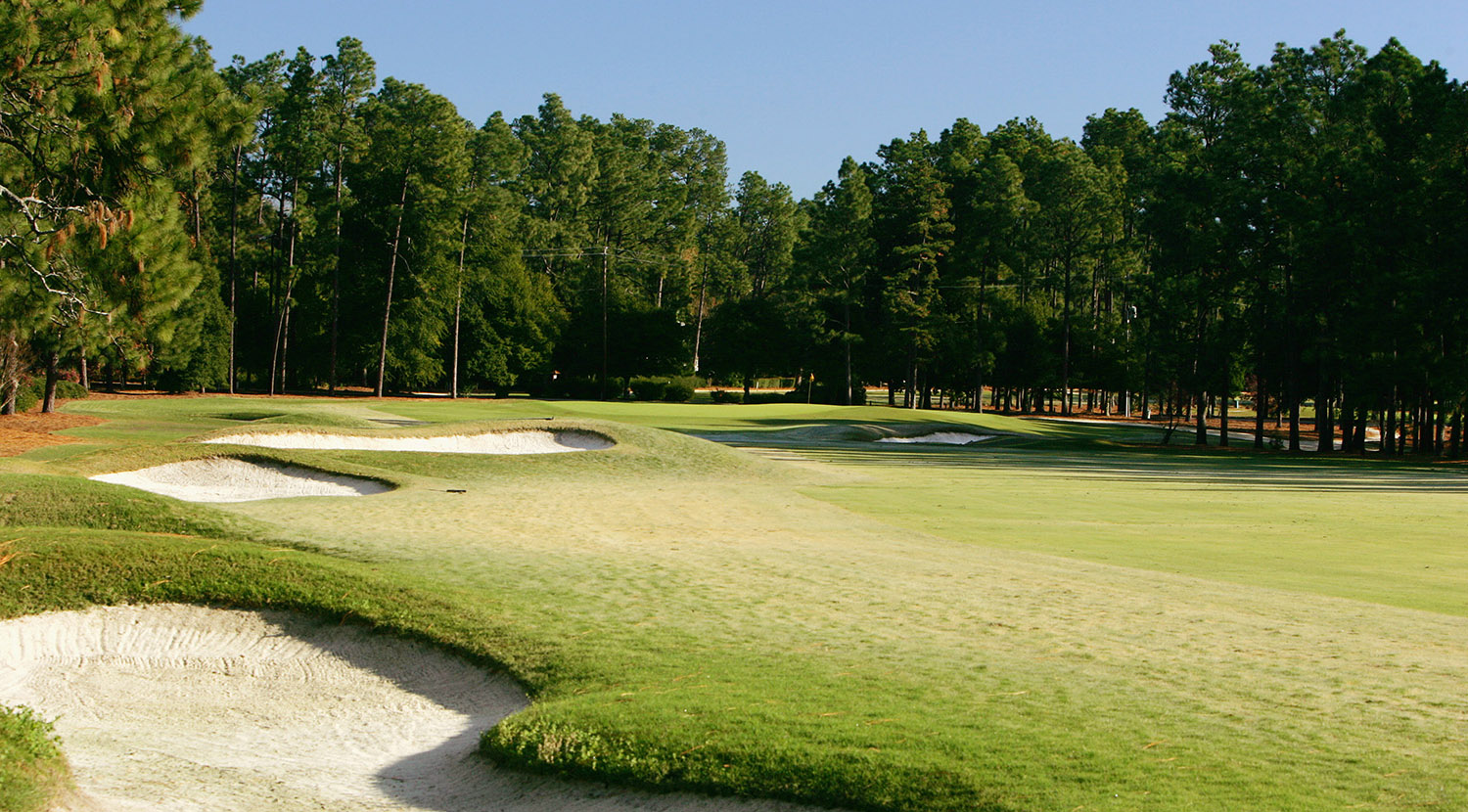
Pinehurst No. 2
North Carolina
Par 4, 439 yards, Handicap 2
Golfers need to be on their game straight from the start on this Ryder Cup compilation as we go from a long par three to one of the toughest par fours in golf at Pinehurst No. 2, the renowned U.S. Open venue which hosted the Ryder Cup in 1951.
The par-four second at Donald Ross-designed Pinehurst typifies this awe-inspiring course, which was brilliantly renovated by Ben Crenshaw and Bill Coore ahead of its last U.S. Open in 2014. Tom Watson rated this one of the best second holes in the world. It’s a slight dogleg to the right and the target for the tee shot is left center of the fairway. The turtle-shell green lends itself to several testing hole locations and golfers need to avoid a sprawling bunker front and right of the green.
We are taking on the second hole at 439 yards, which is plenty, although it reached 507 for the U.S. Open.
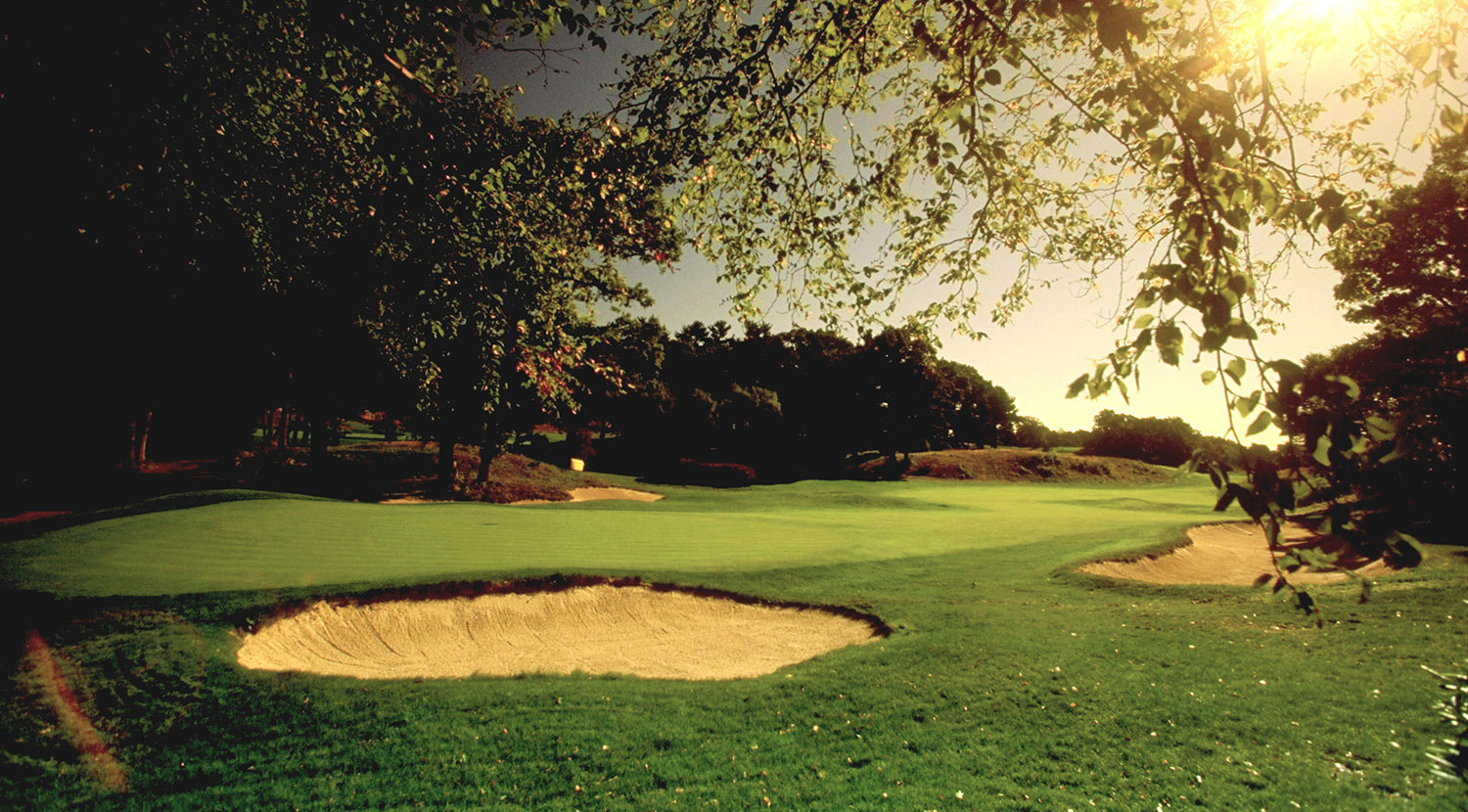
The Country Club
Brookline, Massachusetts
Par 4, 444 yards, Handicap 4
There is no let-up as our Ryder Cup course heads up north to The Country Club at Brookline, one of the oldest golf courses in America. The Country Club was one of the five charter clubs that founded the USGA in 1894 and it hosted the famous U.S. Open of 1913, when local 20-year-old amateur Francis Ouimet—who had grown up caddying at the club—defeated the world’s greatest professionals.
Brookline’s Ryder Cup is equally memorable; the 1999 episode when Ben Crenshaw’s American team were 10-6 down after two days, yet fought back to take 8 ½ of 12 singles points on the final day to win by one.
The par-four third hole played to 451 yards in the Ryder Cup but we are settling for the medal yardage of 444. The dogleg-right hole has early protection from a rocky outcrop on the inside of the elbow, which only the longest of drives can clear, before golfers need to take aim at a small green that is well guarded by sand and by a pond behind.
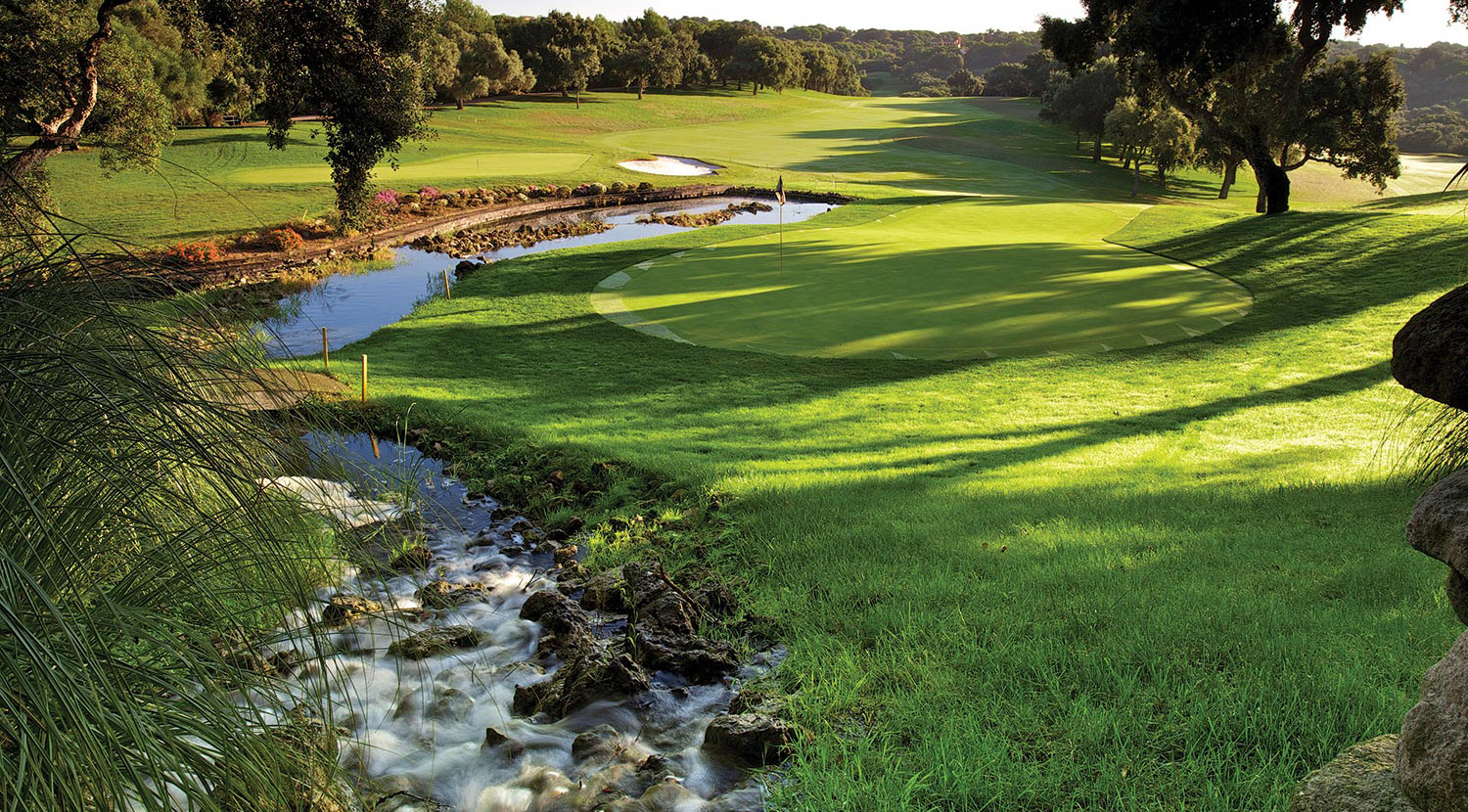
Valderrama
Sotogrande, Spain
Par 5, 537 yards, Handicap 10
Our notional round now heads to the first course in continental Europe to host the Ryder Cup, 1997 venue Valderrama in Spain, where Seve Ballesteros led Europe to victory on what many consider the toughest parkland course in Europe, designed by Robert Trent Jones Sr.
The fourth hole is a classic risk-reward challenge, ideal for match play. From its elevated tee to its raised, two-tier green, which is protected by a cascade at the front, a lake to the right and more water at the rear, the 4th is a creature of breathtaking beauty. “It’s probably the best of all my par-5s”, Trent Jones even said. Even if the Levante is blowing in your favor, a full drive flirting with the left-hand bunker followed by a long, accurate second shot through an oak-lined vista are required to reach the green in two. It is a golfing route taken successfully by very few.
The hole totals 567 yards from the professional tee, so we are giving golfers a better chance of success from the Championship tee at 537 yards.
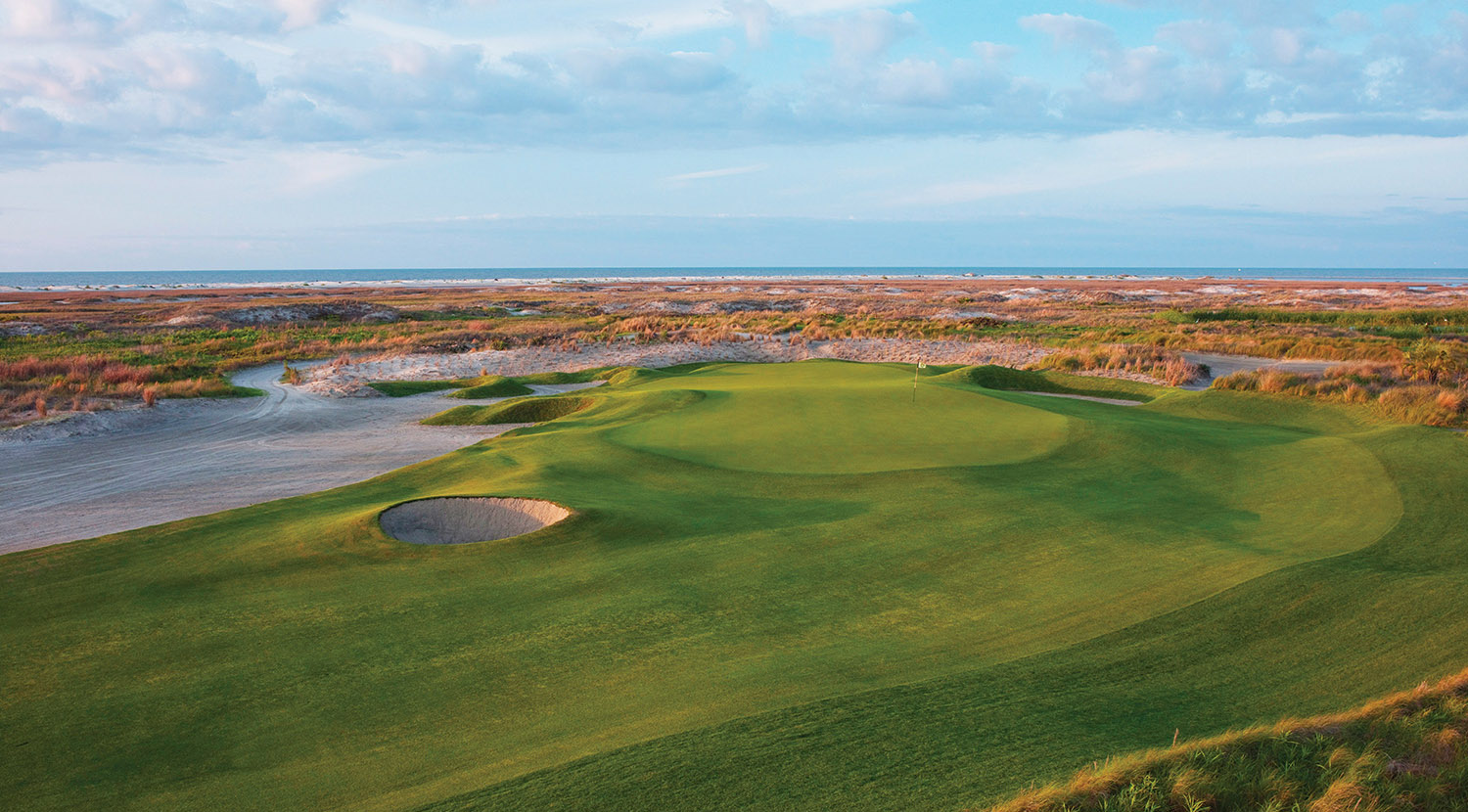
Kiawah Island (Ocean)
South Carolina
Par 3, 185 yards, Handicap 18
Pete Dye’s rugged coastline masterpiece made its entrance back in 1991 when the course was only just finished in time to host the “War on the Shore” Ryder Cup, which the hosts won when Bernhard Langer missed the last putt on the final green. Now firmly and rightly established among the very finest public courses in the United States, the Ocean Course gained major status when it hosted the 2012 PGA Championship won by Rory McIlroy.
For the first par-3 on the Ocean Course and the second on our card, players tee off towards the Atlantic and often into a stiff ocean headwind. For that reason we are playing off the Ocean tee at 185, rather than the Tournament yardage of 207. Leave that one to Rory.
A sandy waste area runs from the tee to a steep face cutting into the middle of an hourglass-shaped green. Dye effectively created two greens in one—it’s 49 yards long with a three-club difference between pin placements—with a large hump across the green’s constricted waist making it vital to land the ball on the same half as the pin.
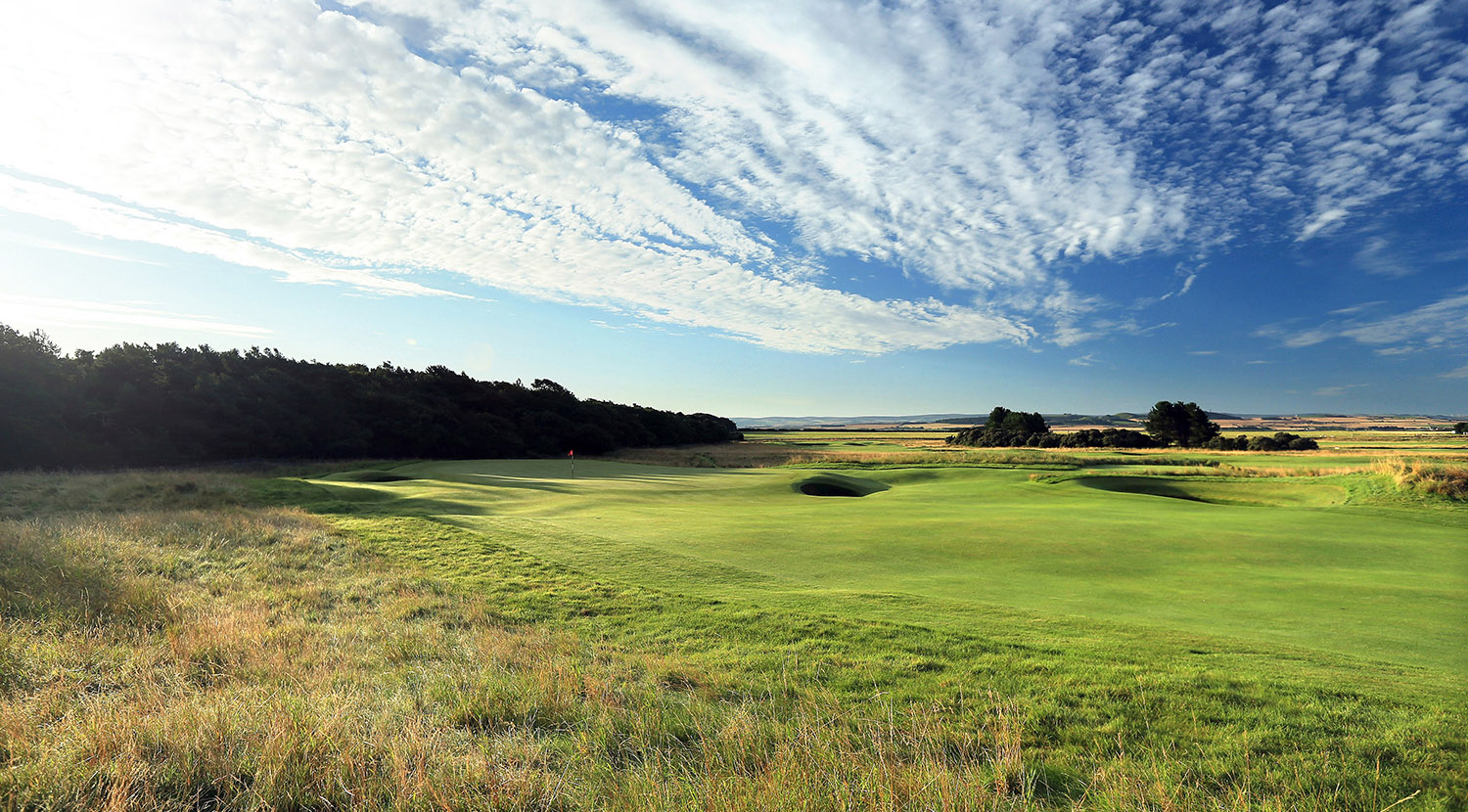
Muirfield
East Lothian, Scotland
Par 4, 440 yards, Handicap 5
Muirfield, home of the Honourable Company of Edinburgh Golfers on Scotland’s east coast, was the first course built specifically to stage a major. Designed by ‘Old’ Tom Morris, it hosted the 1892 [British] Open within 12 months of opening. Revered today as arguably the finest challenge on the Open rota, it was not always so. After its debut, Scot Andrew Kirkaldy—who had finished in a disappointing tie for 13th—described it as “nothing but an old water meadow”.
Harry Colt reconfigured the links in 1923 and it hosted the Ryder Cup in 1973, by which time the ‘GB&I’ team had entered terminal decline as opposition fit to take on the mighty Americans. The visitors cantered to a 19-13 victory.
Muirfield’s par-4 6th, a right-to-left dogleg, is among the most difficult of its 18. Usually played in a crosswind, the hole sweeps down to a climbing green in front of Archerfield Wood. A hidden hollow short of the green creates the impression the pin is closer than it really is. The hole reaches 467 yards from the back but the White yardage of 440 allows for plenty of golf.
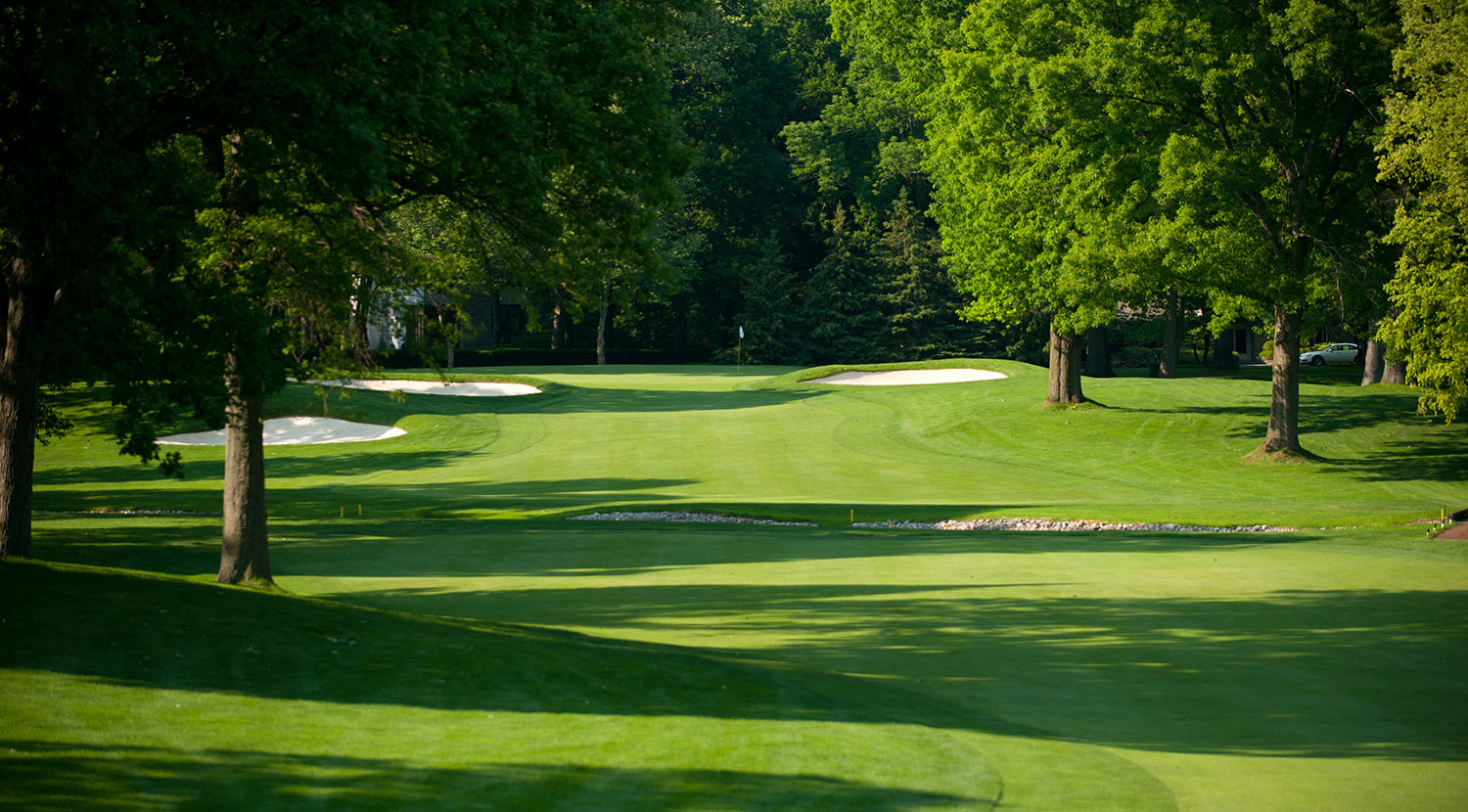
Oak Hill (East)
Rochester, New York
Par 4, 431 yards, Handicap 6
The relentless challenge of our Ryder Cup compilation continues unabated on the East Course at Oak Hill.
Over the past half century, Oak Hill has become established as one of the great major venues of American golf. The club has staged three U.S. Opens and three PGA Championships, most recently the 2013 PGA when Jason Dufner notched his first major title. Boasting a pair of Donald Ross courses, East and West, which opened in 1926, Oak Hill remains the only club to have hosted all of the U.S. Open, PGA Championship, Ryder Cup (in 1995, and won by a European team led by Bernhard Gallacher), U.S. Amateur, U.S. Senior Open and Senior PGA Championship.
The par-4 7th—“Creek’s Elbow”—toys with golfers with a creek that follows a crooked path across the fairway. A patient fairway wood off the tee is the percentage play for the longer hitter, but either way par is always an excellent outcome with second shots directed to a small, well protected green. The Championship tee plays to 461 yards these days, but the Black tee at 431 is all we need.
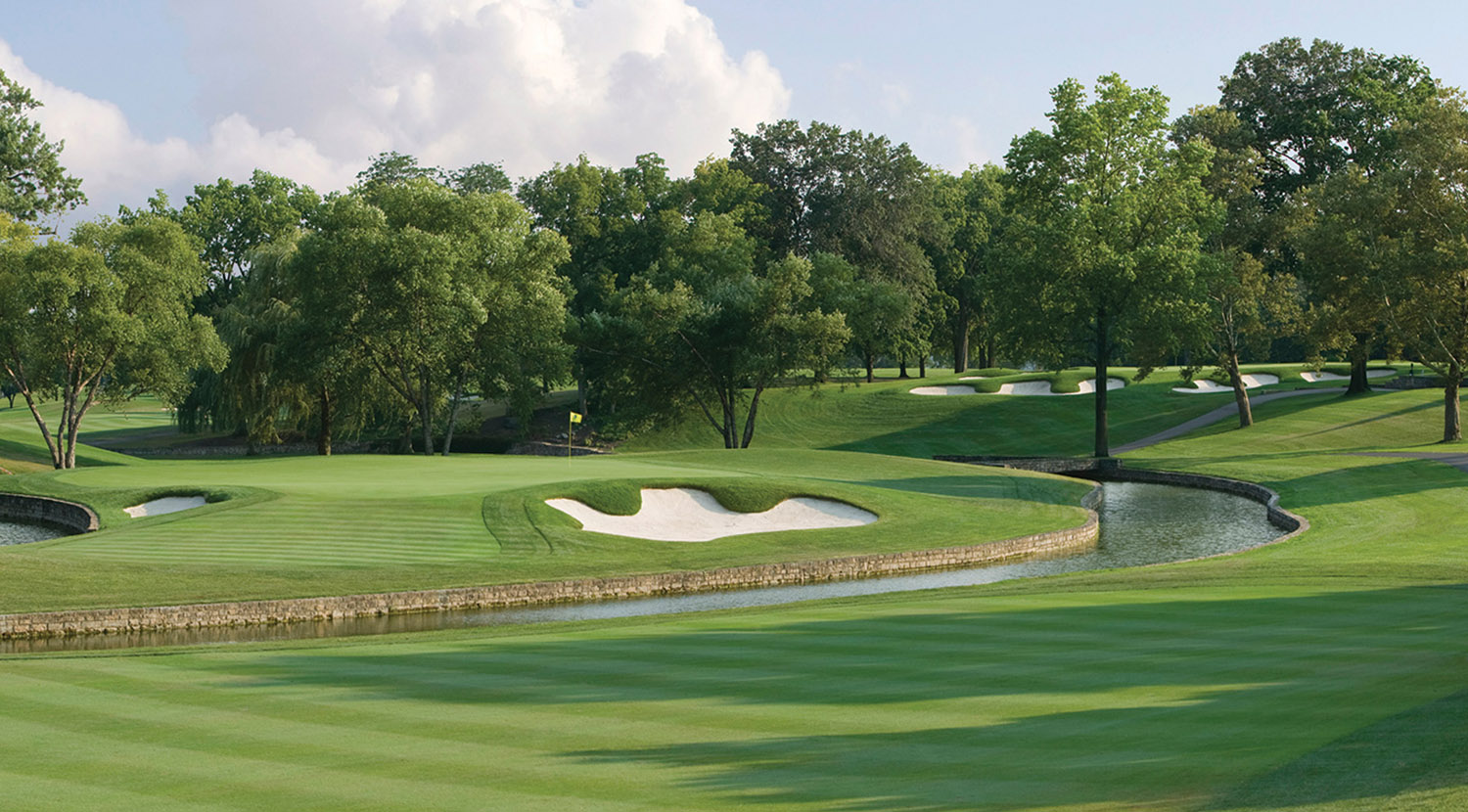
Scioto
Columbus, Ohio
Par 5, 516 yards, Handicap 14
Long before ‘local boy’ Jack Nicklaus made Columbus famous as a fount of golfing excellence, Donald Ross laid down a marker in Ohio’s largest city. Celebrating its centenary this year, Scioto’s esteemed championship heritage features the 1926 U.S. Open, 1931 Ryder Cup and 1950 PGA Championship. Scioto is a shining example of Ross’s design philosophy, forever invoking a strategic approach to course management.
The majestic par-5 8th, perhaps Scioto’s most picturesque hole, is often remembered for reasons other than its beauty. A drive down the left side can find a wide landing area short of a stream that crosses the fairway. An iron to the green is possible from there but the safe shot is to the peninsula just short as the green is surrounded by bunkers and lots of water.
Sometimes played as a 502-yard par four in championships, with so much trouble surrounding the green we are sticking to the Blue yardage of 516 with the extra shot. You’ll need it.
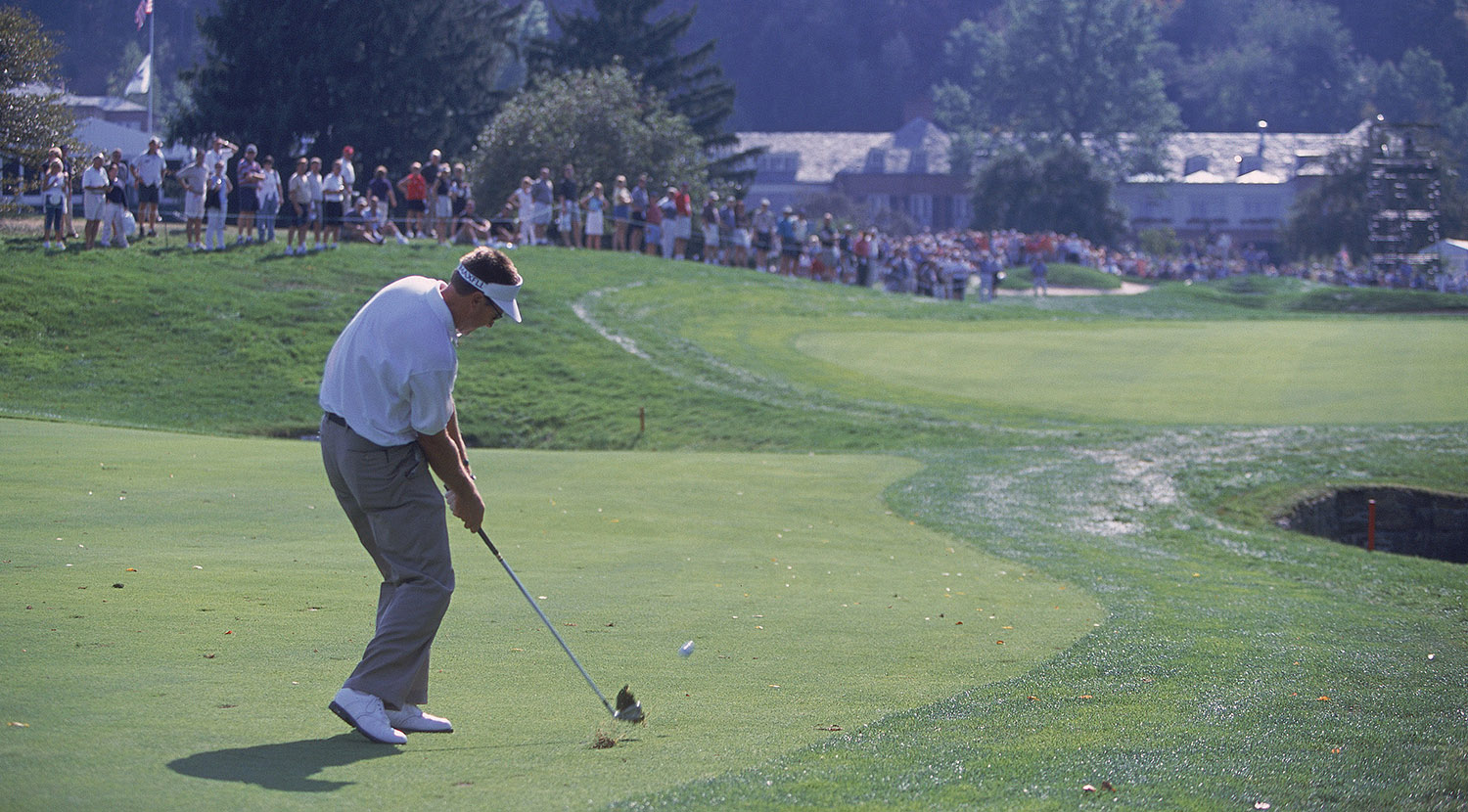
Laurel Valley
Ligonier, Pennsylvania
Par 4, 395 yards, Handicap 8
Built in 1959 by Dick Wilson and redesigned by Arnold Palmer in 1988, Laurel Valley staged the 1965 PGA Championship and the 1975 Ryder Cup when Palmer led the U.S. to a resounding victory in what would be GB&I’s penultimate Ryder Cup outing before bringing in the rest of Europe.
The 9th is a long, uphill par-4 played into the prevailing wind with the clubhouse overlooking beyond, and it is consistently the toughest hole on the course. Even though the fairway is relatively wide and straight, the elevation makes it difficult to see the green when playing the second shot. About 100 yards out the small stream that runs down the right side of the hole cuts across and can easily come into play. Some big pines nearer the green, also on the right, should also be given a wide berth. The difficulties don’t end there because the green has two tiers and three putts are a distinct possibility for anyone on the wrong level.
The Blue tee at 481 yards renders the hole a monster, so at the end of a long a generally brutal Ryder Cup 9, we are going off the White tee at 395 yards.
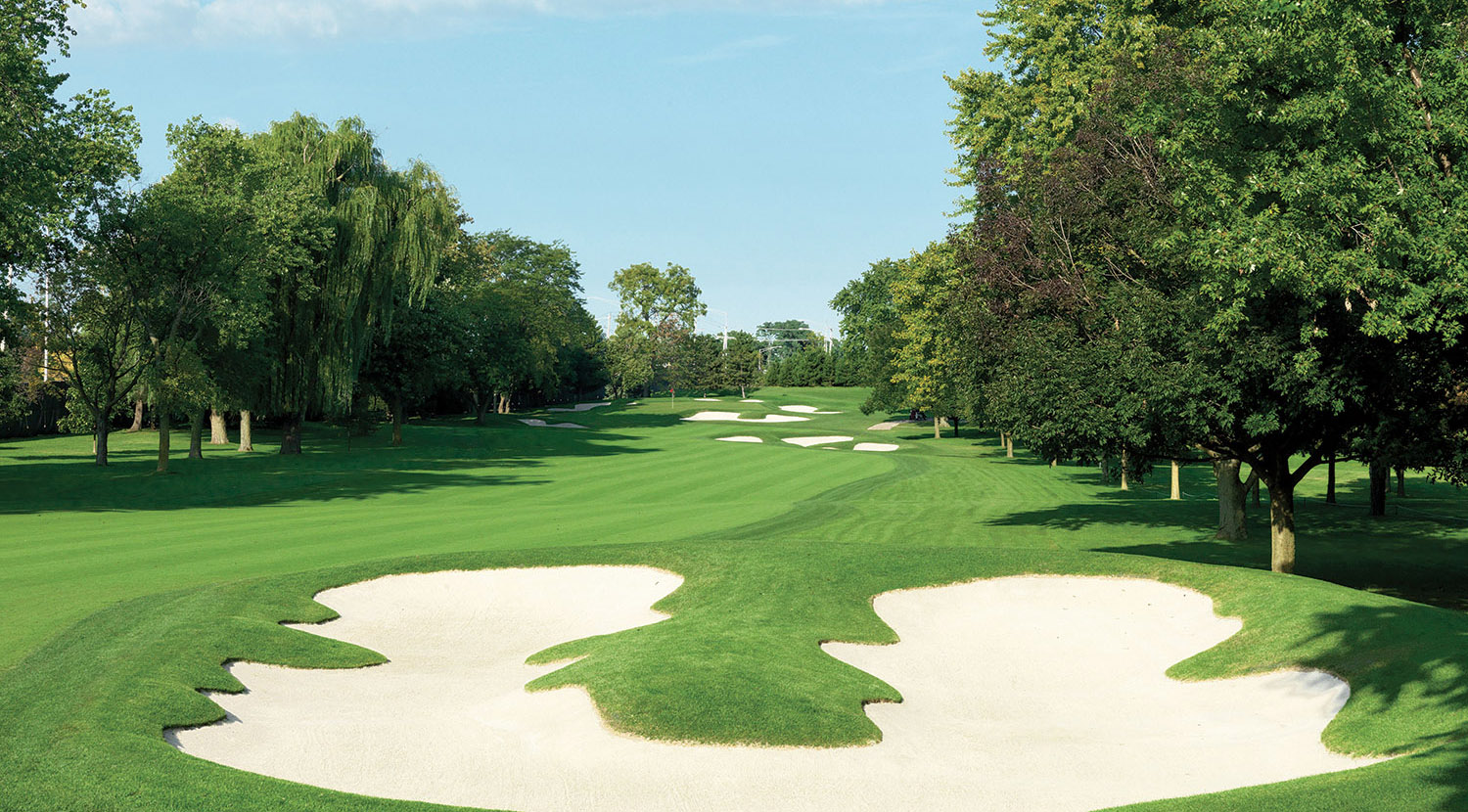
Medinah (No. 3)
Chicago, Illinois
Par 5, 555 yards, Handicap 13
At the 2012 Ryder Cup—which will forever be remembered as the “Miracle of Medinah” in Europe, not so much in the US—this long par-5 proved a pivotal hole in several matches, not least because it demands pinpoint accuracy and a fearless mindset as well as gargantuan length off the tee. Long hitters have the advantage if they can drive the ball to the top of the hill that crowns the middle of the fairway. They should then have a long-iron or metal-wood into a green that is well protected by a semi-circle of bunkers and what seems like an umbrella of overhanging branches.
The hole played 578 yards in the Ryder Cup but we are bringing more golfers into range by playing off the White tee at 555.
Medinah is one of the grand clubs of the American north, founded in 1924 by Shriners from Chicago’s Medinah Temple. Its course No. 3 was designed by Tom Bendelow and opened in 1928, with the original intention of being a ladies’ course. In addition to the Ryder Cup, No. 3 has hosted the PGA Championship twice and the U.S. Open three times.
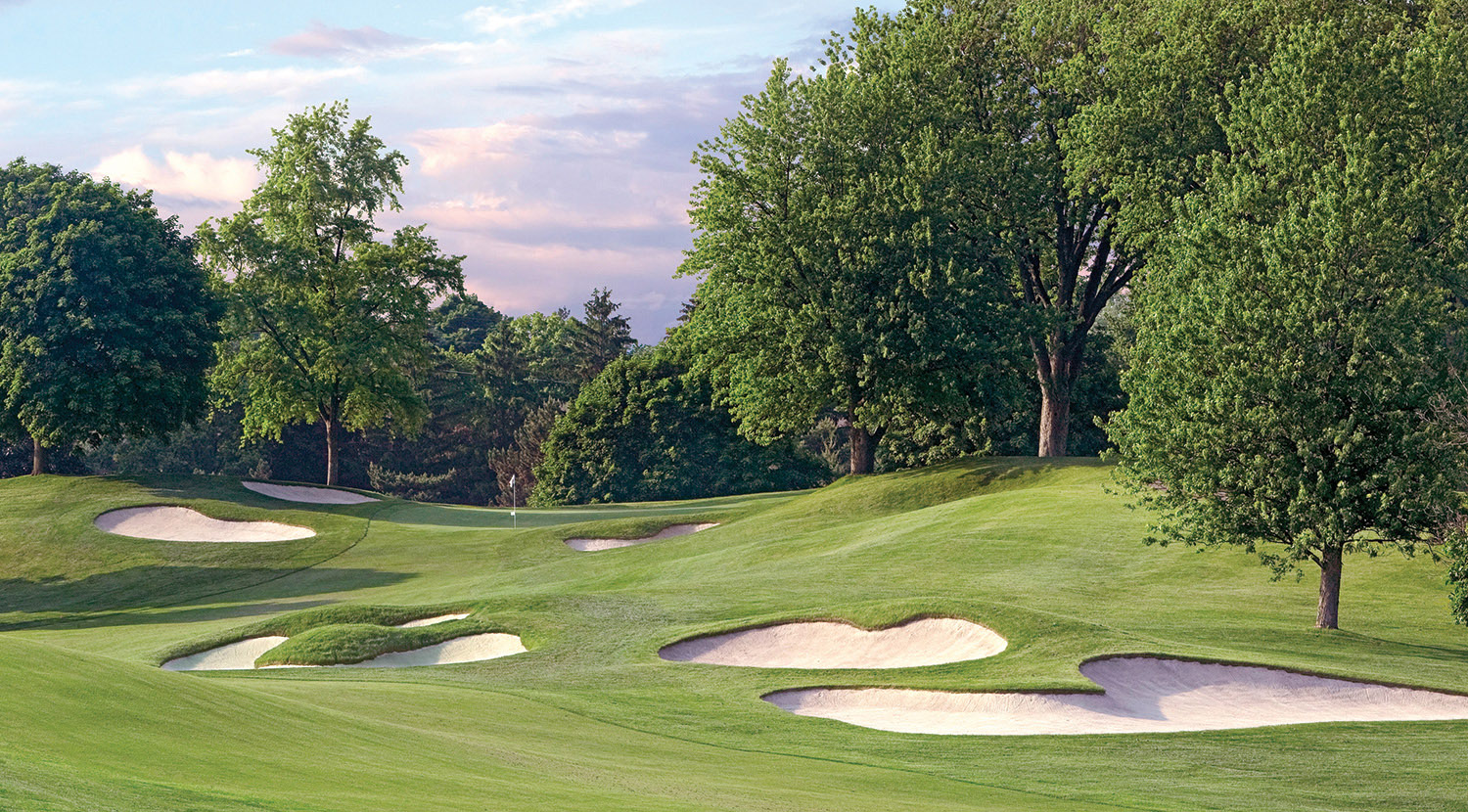
Oakland Hills (South)
Bloomfield Hills, Michigan
Par 4, 400 yards, Handicap7
The renowned South Course at Oakland Hills, outside Detroit, was originally designed by Donald Ross and opened in 1918, and it was later adapted by Robert Trent Jones Snr. It was after Trent Jones’ work that Ben Hogan referred to the South Course as ‘The Monster’—after Hogan had won the 1951 U.S. Open there—and the course has been frequently lent to the USGA and PGA of America to stage six U.S. Opens, three PGA Championships and the 35th Ryder Cup in 2004.
The 11th on the South Course is not all that long by modern standards yet par is always a good score. A long, straight drive will set up a short-iron approach for which accuracy is critical as the back tier of the green is four feet higher than the front. The hole played 423 yards in 2004 although we are edging up to the Blue tee and a distance of 400.
By the way, the first club professional at Oakland Hills was Walter Hagen, whose original pro shop was housed in what had previously been a chicken coop.
Champions (Cypress Creek)
Houston, Texas
Par 3, 181 yards, Handicap 16
Champions Golf Club was built by two Texan legends, Jimmy Demaret from Houston and Jack Burke Jr from Fort Worth, who earned five major titles between them. Demaret was the first golfer to win the Masters three times, in 1950.
They built Champions in 1956 and the club’s tournament course, Cypress Creek—designed by Ralph Plummer—was only 10 years old when it hosted the 1967 Ryder Cup, when the United States inflicted the heaviest defeat in the history of the competition, smashing Europe 23½ – 8½. The US team was captained by Ben Hogan, who famously threatened to leave Arnold Palmer out of the American line-up. Ultimately, Palmer played in four out of the five series and delivered four points out of four.
A swirling wind at the par-3 12th can be the hole’s greatest defence, although a pond to carry has counted for many penalties, most notably to Bob Hope, who was reportedly the first to dunk a ball in there soon after the course opened. It has been “Bob Hope Lake” ever since. 213 yards from the back, we are opting for the middle tee at 181.
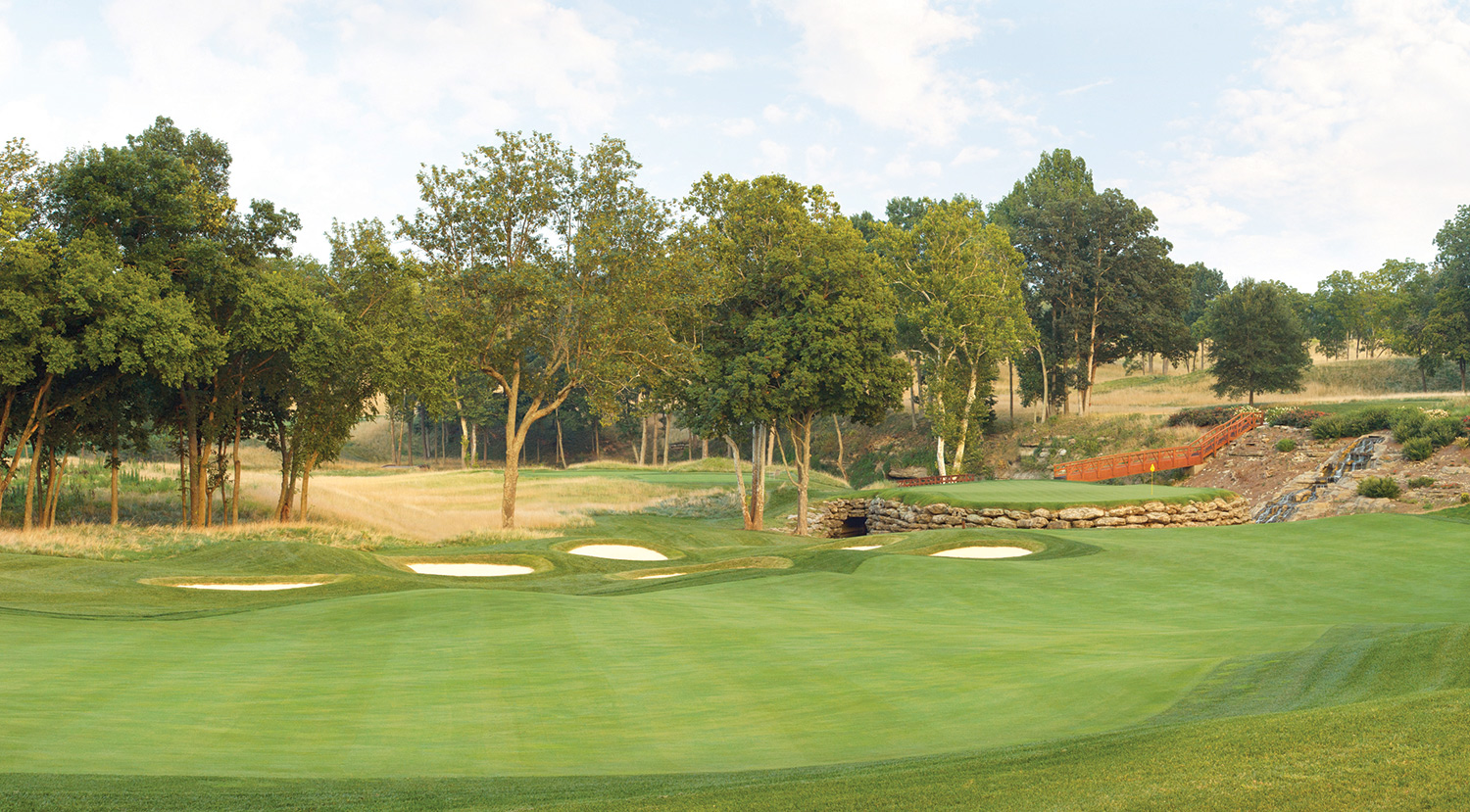
Valhalla
Louisville, Kentucky
Par 4, 355 yards, Handicap 15
Valhalla—which in Norse mythology is the great hall in which the souls of slain Vikings celebrate with the gods—was the brainchild of Kentucky businessman Dwight Gahm, although the club is now owned outright by the PGA of America. The club opened in 1986 with the scale of the golf course particularly striking; the 18-hole course, clubhouse and immaculate facilities occupy an enormous 486-acre plot of rolling, partly wooded Kentucky countryside.
The relatively young course has already hosted three PGA Championships—most recently in 2014—and also the last Ryder Cup to be won by the United States, when Paul Azinger masterminded the irresistible American force in 2008.
Valhalla boasts memorable holes at every turn, but none more so than its 13th, one of the most attractive short par-4s you can find. Measuring 355 yards from the back and downhill most of the way, the fairway veers left, with a network of bunkers protecting the left flank, before golfers must negotiate a raised green that is virtually an island, with water reaching around the front and both sides. It is only a wedge for most but too much spin will plummet the ball to a watery demise.
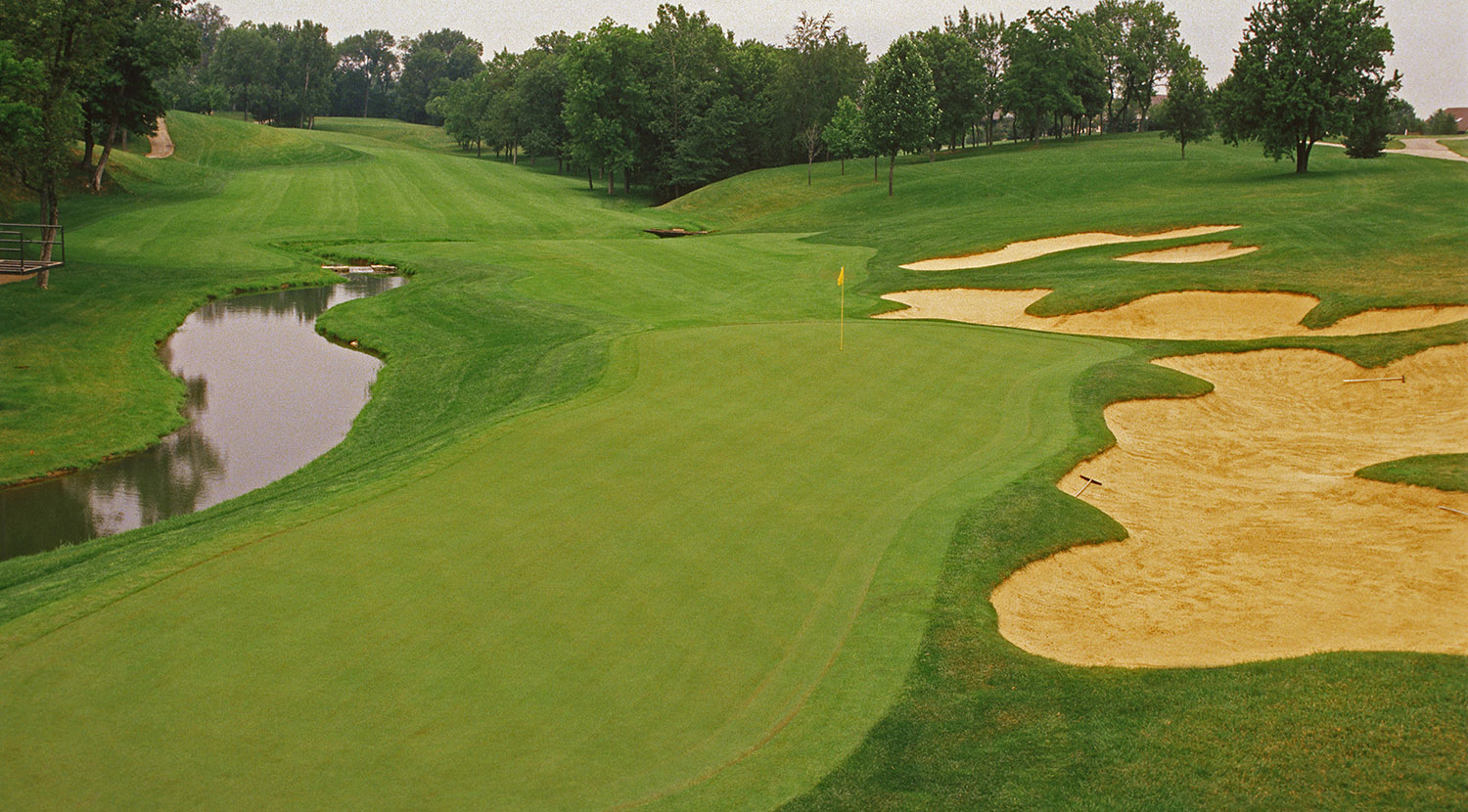
Muirfield Village
Dublin, Ohio
Par 4, 363 yards, Handicap 12
Taking the Ryder Cup to “the course that Jack built” in 1987, with Jack Nicklaus serving as captain of the US team in his home town, was supposed to be a combination just too evocative, too fateful, for anything other than a home win. But the Ryder Cup takes little notice of sentiment, as we were vividly reminded with Tom Watson’s flawed captaincy in 2014.
Also working against Nicklaus in ’87 was Tony Jacklin—arguably the greatest Ryder Cup skipper of them all—who was leading the European team for the third time. He was in his stride and he had Ballesteros, Faldo, Olazabal, Woosnam, Lyle and Langer in theirs and Europe won the Ryder Cup in the US for the first time.
The shortest par-4 at Muirfield Village, its 14th, is as eye-catching as it is difficult. Starting downhill, golfers need to find the middle of the tree-lined fairway to give them the best chance of succeeding with a treacherous approach to a green guarded by bunkers to the left and water to the right. Nicklaus has said the biggest challenge for golfers at 14 is not letting the second shot “over-intimidate” them. The championship yardage is 363 and that works for us.
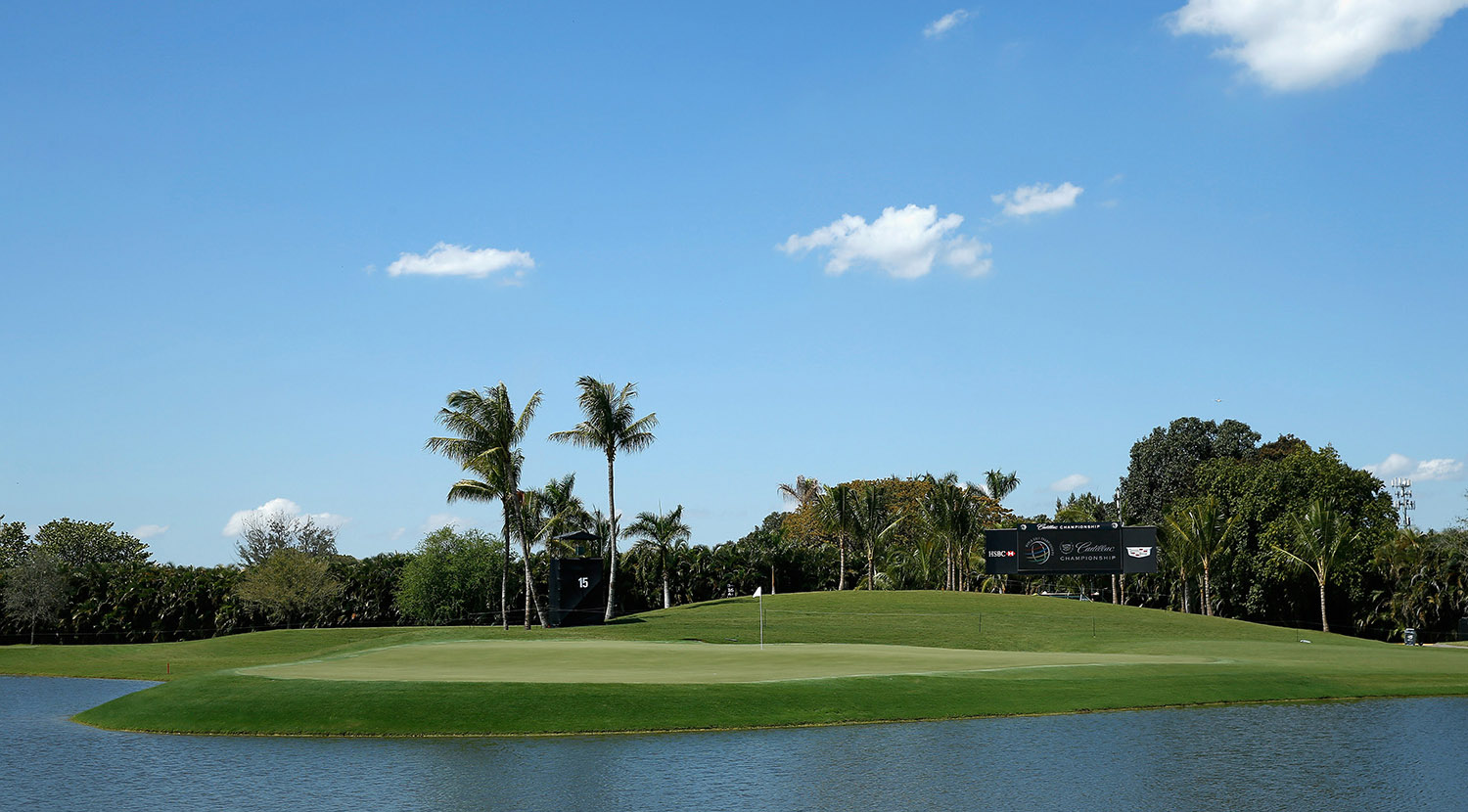
PGA National (Champion)
Palm Beach Gardens, Florida
Par 3, 163 Yards, Handicap 17
And so we enter the “Bear Trap,” arguably the toughest three-hole stretch on the PGA TOUR. The Champion course at PGA National was originally designed by Tom & George Fazio, before being reworked by Jack Nicklaus in 2014, and it is home to the Honda Classic. The Bear Trap incorporates holes 15, 16 and 17.
Wrote Karen Crouse of The New York Times: “The Champions layout at PGA National is 7,140 yards of venom, a king cobra of a course that rises without warning to strike down the world’s best golfers. Snake charmers may have a better chance of taming it.”
The par-3 15th has changed since the course staged the 1983 Ryder Cup—when Nicklaus successfully captained the US team for the first time—but it remains a slicer’s nightmare, with a lake dominating short of the green, to the right and long. Playing 176 yards on tour, and a club shorter on our card at 163 off the gold tee, a broad bunker awaits a pulled tee shot, although golfers are permitted a bail-out area, short and left. Says Nicklaus: “It’s about precision. It’s about guts.”
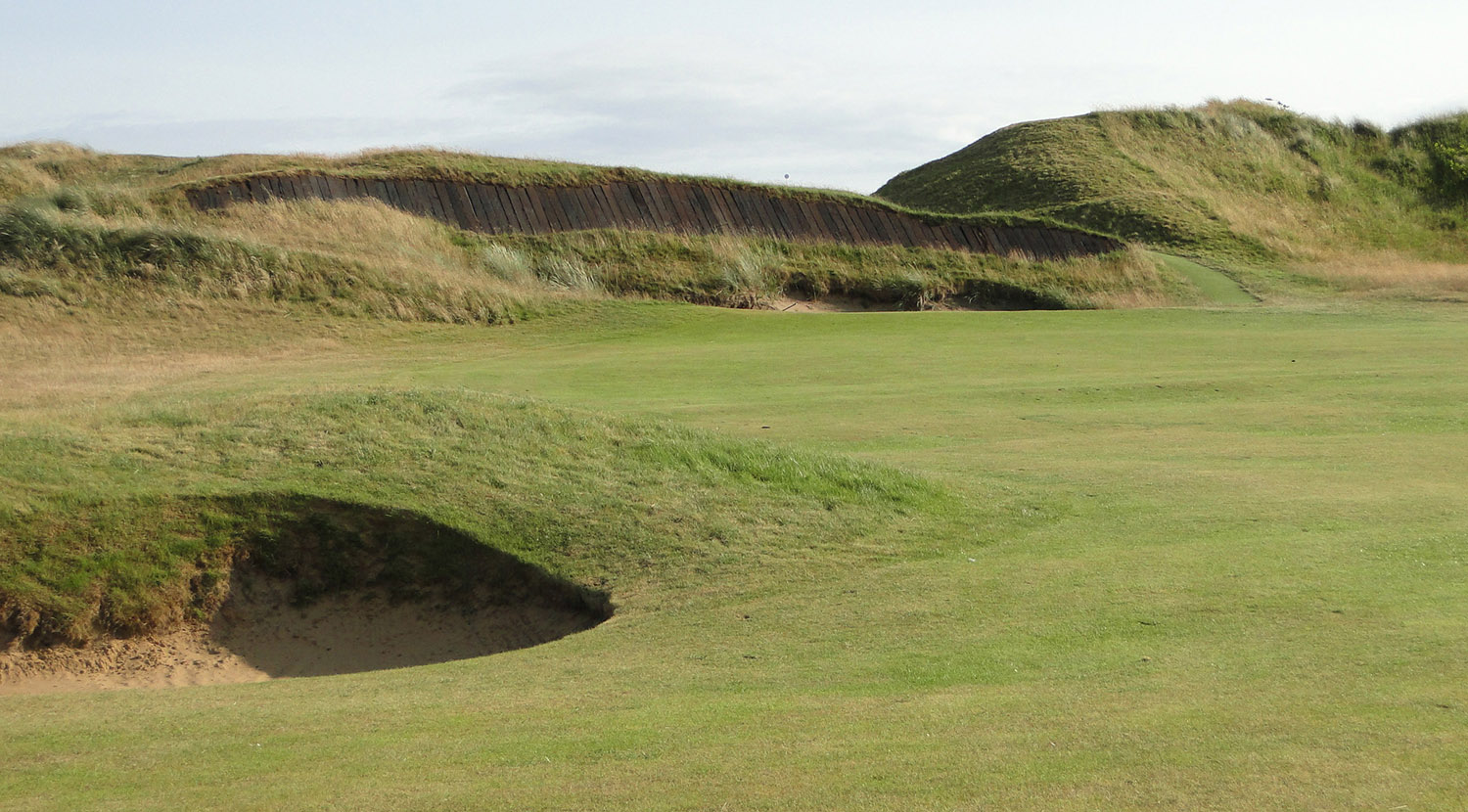
Southport & Ainsdale
Lancashire, England
Par 5, 528 yards, Handicap 9
Southport and Ainsdale Golf Club, or ‘S&A’ as it is commonly known, is home to one of England’s great links courses although as it has never hosted The [British] Open it does not carry the same kudos as its neighbor Royal Birkdale.
Scotsman James Braid—the first golfer to win the Open five times—laid out the S&A links in 1925 and acclaim soon followed when it was chosen to stage the Ryder Cup in 1933 and again in 1937. GB&I won in ’33 with Walter Hagen’s visitors taking the cup home in ’37.
The most famous hole at S&A is it’s mighty 16th—also known as ‘Gumbleys’ after one of the club’s founder members. We are opting to play off the back tee here to savor the full experience into the prevailing wind. The outstanding feature of this hole is what must be negotiated with the second shot as a band of rugged sandhills and mounds cut right across the fairway, in the middle of which lies a bank of railway sleepers above two bunkers. The sleeper-armored sandhills rise up over 20 feet, rendering the second shot blind, and a mishit shot played into the sleepers is a dispiriting experience best avoided.
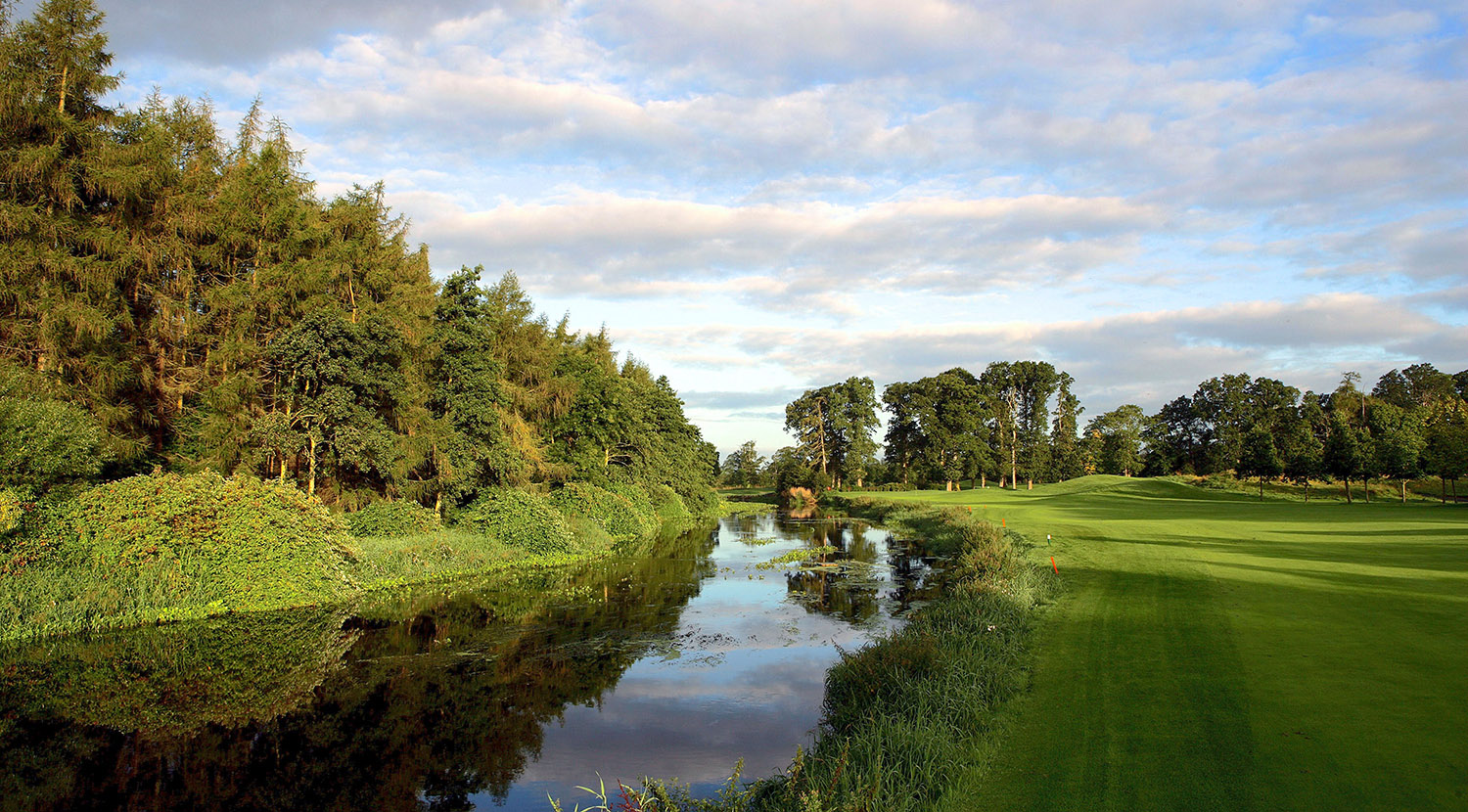
K Club (Palmer Ryder Cup)
County Kildare, Ireland
Par 4, 424 yards, Handicap 3
The Palmer Ryder Cup course opened in 1991 but before a single shot had been struck here, designer Arnold Palmer suggested to owner Michael Smurfit that the course would provide the perfect stage for the 1993 Ryder Cup. The Belfry got the ’93 event but four years later Palmer’s recommendation became reality when the K Club was awarded the 2006 event, won by Ian Woosnam’s home team.
Named ‘Half Moon’, the demanding right-to-left dogleg 17th requires accuracy and commitment from the tee. The River Liffey will swallow a pulled or hooked drive (for the right-hander) while there is little solace for those who choose to bailout right towards thick woodland. Palmer says: “The ideal drive is down the left side of the fairway but this is very risky. Much easier is to hit a long iron or rescue club to the middle right of the fairway, but this can leave a lengthy shot into the green.” With the putting surface also sloping sharply from right to left towards the Liffey, a delicate touch is essential around the green.
The 17th played to 424 yards in the 2006 Ryder Cup and we are heading to that Blue tee for our penultimate hole.
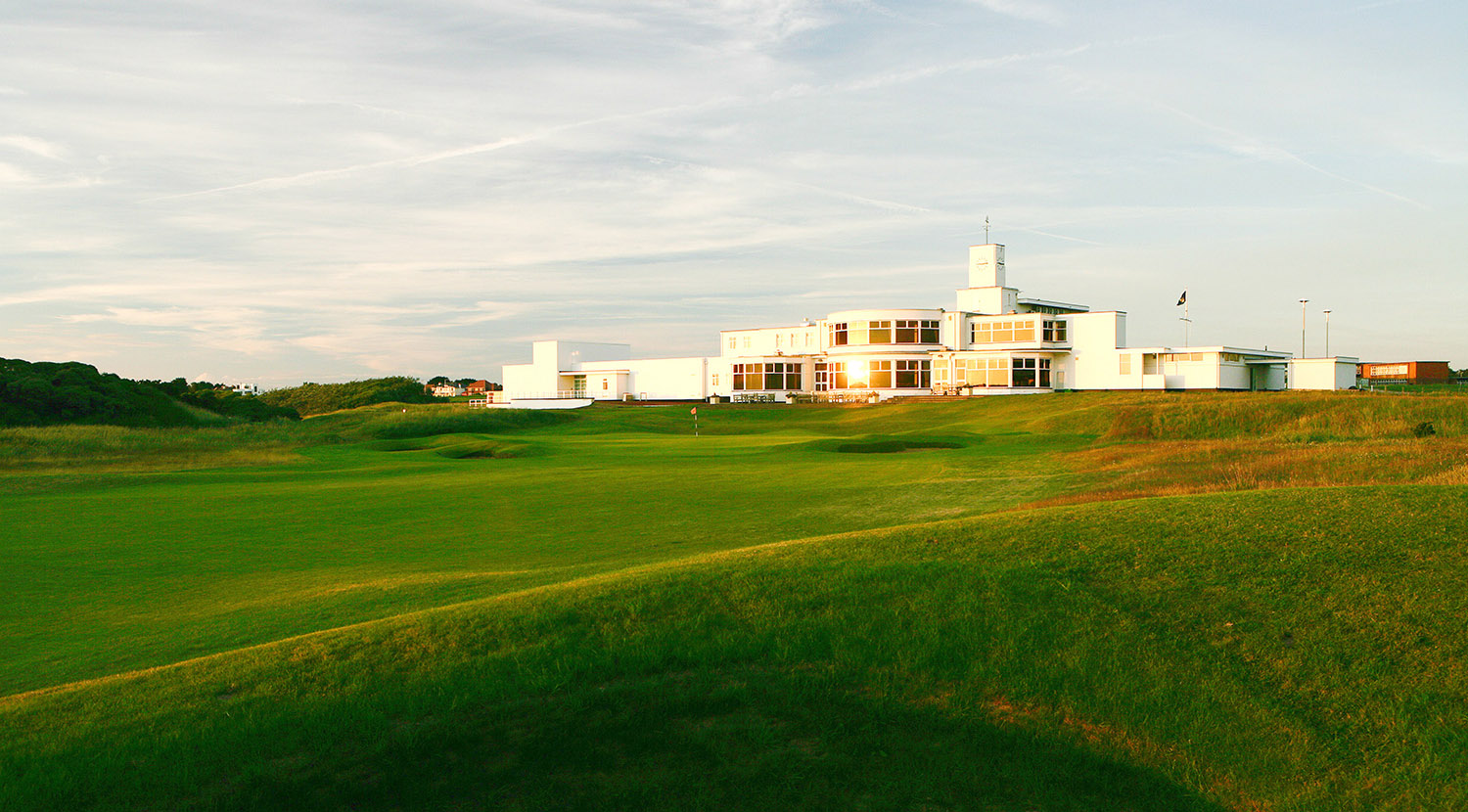
Royal Birkdale
Lancashire, England
Par 4, 472 yards, Handicap 1
Famed for its magnificent sand dunes, Royal Birkdale was the scene of Arnold Palmer’s first victory in the [British] Open in 1961 and the club owns an Open heritage that stretches far beyond. The Ryder Cup was played here twice, in 1965 and 1969, and it was on this 18th green where Jack Nicklaus made golf’s most famous concession, picking up opponent Tony Jacklin’s marker for a two-foot putt that the Englishman needed to secure a half in their decisive singles match. The halved point halved the overall score for the first time in Ryder Cup history, at 16-16.
Birkdale has one of golf’s toughest finishing holes. Played by the members as a par-5, as a par four in championship play it offers a true test of nerve. The best line off the tee is down the right of the fairway but out of bounds also lurks. Playing safe with a 3-wood leaves a lengthy approach through a narrow entrance to a backwardly sloping green guarded by three bunkers.
The final decision is whether to play the 18th as a par-4 or 5. Well, in matchplay the par is irrelevant so we’ll go for 4 to give our compilation a tidy closing par of 72.

Follow Us On


| Cookie | Duration | Description |
|---|---|---|
| cookielawinfo-checkbox-analytics | 11 months | This cookie is set by GDPR Cookie Consent plugin. The cookie is used to store the user consent for the cookies in the category "Analytics". |
| cookielawinfo-checkbox-functional | 11 months | The cookie is set by GDPR cookie consent to record the user consent for the cookies in the category "Functional". |
| cookielawinfo-checkbox-necessary | 11 months | This cookie is set by GDPR Cookie Consent plugin. The cookies is used to store the user consent for the cookies in the category "Necessary". |
| cookielawinfo-checkbox-others | 11 months | This cookie is set by GDPR Cookie Consent plugin. The cookie is used to store the user consent for the cookies in the category "Other. |
| cookielawinfo-checkbox-performance | 11 months | This cookie is set by GDPR Cookie Consent plugin. The cookie is used to store the user consent for the cookies in the category "Performance". |
| viewed_cookie_policy | 11 months | The cookie is set by the GDPR Cookie Consent plugin and is used to store whether or not user has consented to the use of cookies. It does not store any personal data. |